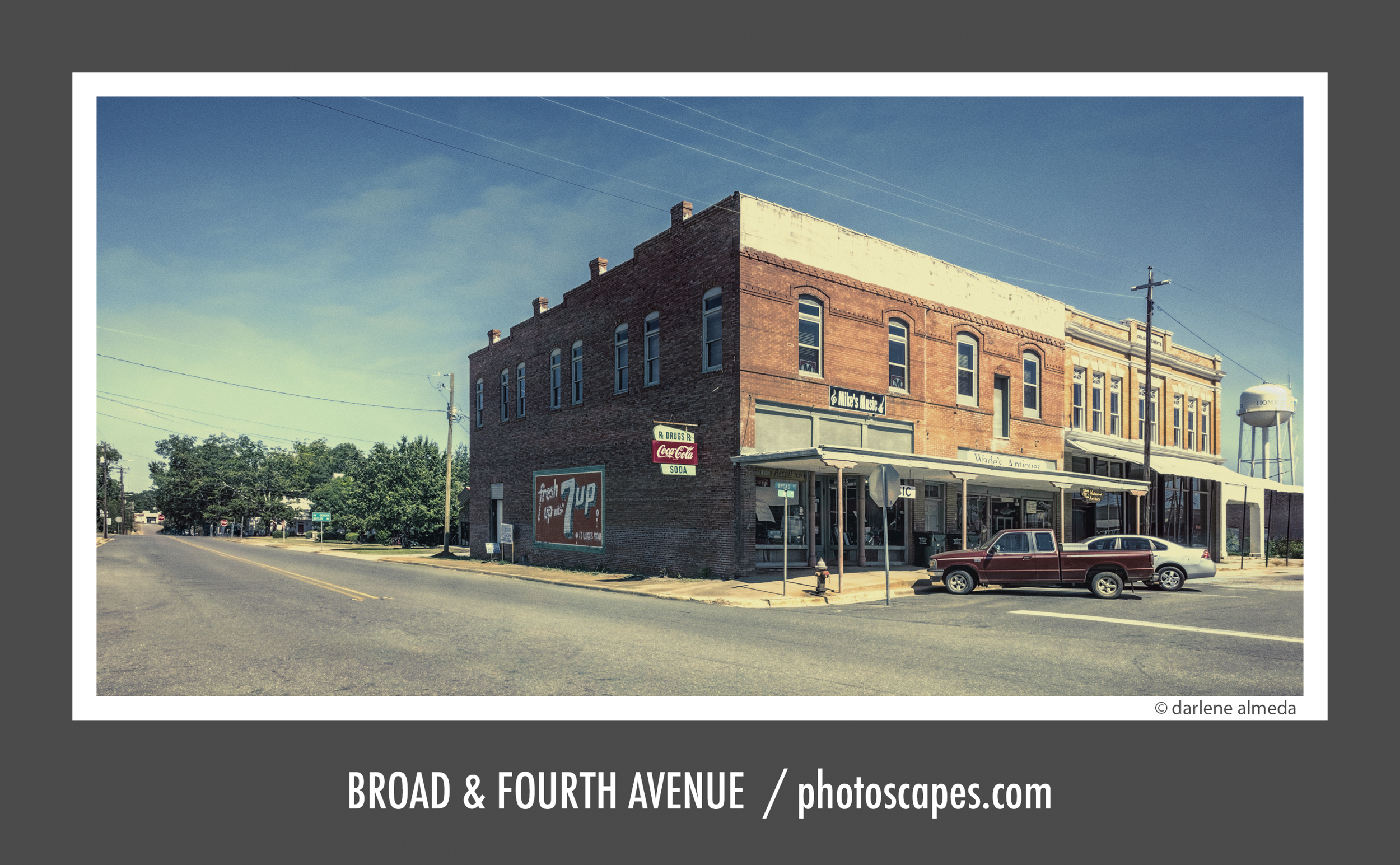Broad & Fourth Avenue, Buena Vista, GA
Photographed October 1, 2016 — Posted October 1, 2025
Sometimes the calendar surprises me. I photographed Buena Vista, Georgia, on October 1, 2016, and now, exactly nine years later, I’m sharing it here.
This little town embodies so much of what I love about rural America: a main street or two, faded brick storefronts, no traffic lights, and—at least in the South—a town square at the center of it all. Sadly, the reality is that since the pandemic, the town has struggled, and none of the businesses pictured here remain today.
Although this image might be categorized as “street photography” because of the large portion of roadway in the frame, it’s not a genre I practice often. To me, this photograph falls more naturally into Americana. It could even be viewed through the lens of architectural photography, but in my heart, it simply whispers American.
Having once lived, studied, and worked in Brooklyn and Manhattan, I know the energy of the city well, but I’m not a city gal. My roots run through the New Jersey Pine Barrens, where I spent part of my youth wandering the woods and learning the history of my grandmother’s Native American farming ancestry. Those early experiences shaped my love for quieter landscapes, and after marriage, I moved south to Georgia and later to North Florida, where I’ve happily remained.
Street photography often feels invasive to me, and since I tend to be a private person, it’s never been a natural fit. I admire masters like Saul Leiter and Ernst Haas, who infused the genre with art, mood, and narrative, but much of street photography still feels too random and disconnected for my sensibilities. I prefer exploring small towns where life moves a bit slower—places that feel more intimate, more grounded, and more in tune with the pace of life I’ve chosen.
What a Small Town Offers
What does a small town offer that a big city does not? For me, it is solitude.
When I lived in New York City, it was for schooling and work. I was very young, just starting in life, and the city was electric. My career experiences there were remarkable, filled with opportunities and people I knew I could not have met anywhere else. Those years taught me two important lessons: first, that I could take my abilities anywhere and make a living, which was vital to me as an independent artist; and second, something more personal: I thrive on peace and quiet.
After work, I would climb a mountain of stairs, unlock the deadbolts on my apartment door, and feel completely drained of inspiration. An unfinished painting sat on the easel in my makeshift art studio, a canvas I painted over again and again until it became nothing more than a muddy blur. What held me instead was the window light: soft, shifting, alive. Within those twelve-foot walls, photography became my elixir, the creative force that replaced paint and brush.
During that time, I had moved on from my first SLR, the Canon AE-1, to the Nikon F3, with Hasselblads quietly catching my eye in the glossy pages of photography magazines. The camera called to me, yet I never felt safe carrying it into the city streets. My purse had already been stolen once, snatched from my desk drawer at the ad agency by a deliveryman who slipped away before even the doorman could stop him.
Deep down, I knew the pull of the city’s chaos would never be mine. What I longed for was the quiet of smaller places, where the pace of life invites reflection through the lens; the kind of solitude I continue to find in the quiet corners of small towns, and in the endless, restorative embrace of nature.
The city gave me work as an advertising artist, but the light I needed for my own art faded there. It returned only in slower places, a truth I’ve kept since New York.
Closing Reflection
Standing on the corner of Broad & Fourth, I felt that familiar calm, the kind of stillness that restores rather than drains. The faded storefronts and empty square may speak of economic decline, but to me, they carry a more profound truth: small towns, even in their silence, hold space for reflection, memory, and the peace I have always sought. This photograph is not just a record of a place; it is a reminder of why I chose this life, far from the city’s noise, where stillness becomes its own kind of inspiration.
My path toward quiet unfolded gradually, after fifteen years of running a bustling studio in Atlanta where, in a single week, I might photograph hundreds, sometimes thousands, of people. Away from the job, clients often stopped me to share how much my work had meant to them and their families. I always greeted them with gratitude and a smile, yet I could rarely recall their names. These were people I had photographed on their wedding day or during milestones that defined their lives, moments of deep and lasting meaning for them. But unless their job folder was in front of me, the details slipped away. That disconnect troubled me more than I could explain, a quiet but persistent truth I could not ignore.
In the end, I left the busy studio life and crowded pace of the city behind, trading it for nature’s quiet beauty, where my work could finally breathe and renew itself.
I hope you, too, have found a place that offers peace, joy, and the inspiration to pick up the camera, or simply to see the world, with renewed vision.

